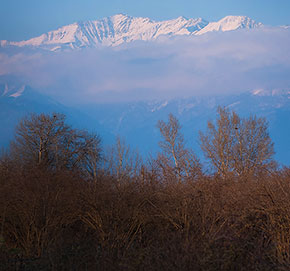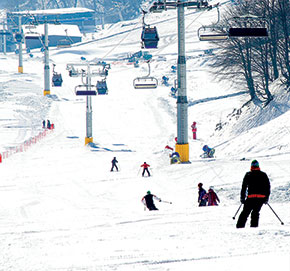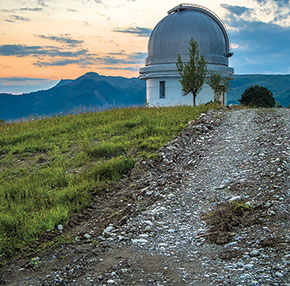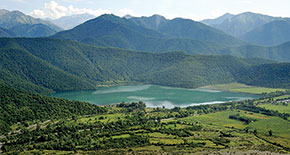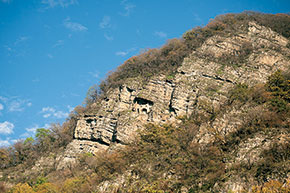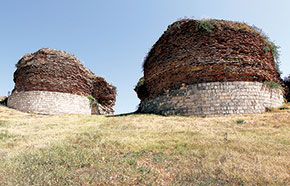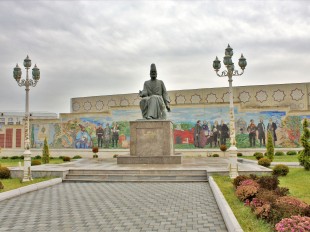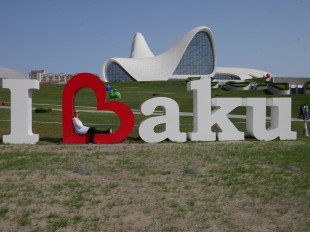Azerbaijan’s lush, mountainous northern territory, spanning from the Caspian Sea along the Greater Caucasus Mountains to the border with Georgia, is just waiting to be discovered. To help you get to grips with the region, Eldar Farzaliyev has compiled a list of 20 things to do in the country’s rugged, culturally rich and expansive north.
GOBUSTAN
1. THE DIRI BABA TOMB
The Diri Baba Tomb (mausoleum) is a mosque dating from 1402 built into the side of a cliff with ancient rock carvings. It was here, on the way from Baku to Shamakhi, that a saint named Diri Baba was buried. Many myths and legends are tied to the Diri Baba Tomb and hence it’s been drawing pilgrims since the 17th century.
The mausoleum’s smooth exterior contrasts with its rocky surroundings to form a beautiful 15th century monument, and it is rightfully today considered a masterpiece of the Shirvan architectural school.
SHAMAKHI
2. THE SHAMAKHI ASTROPHYSICAL OBSERVATORY
The Shamakhi Astrophysical Observatory is located 1500m high in the southeastern range of the Greater Caucasus Mountains, 150 km from Baku near the city of Shamakhi, one of Azerbaijan’s most historic cities. The observatory was opened during in 1960, after an earlier astronomical expedition seeking a suitable spot to build an observatory in the Azerbaijan Soviet Socialist Republic settled upon this site in the Pirqulu region.
The observatory works broadly across three areas - the physics of stars, investigating the solar system and solar-terrestrial relations - and has contributed significantly to Soviet and post-Soviet astronomy. In 1981 it was named after Nasiraddin Tusi, a medieval mathematician, physicist and astronomer who established a renowned observatory (Maragha Observatory) in South Azerbaijan (now Iran) in the 13th century.
The best time to go for solar observations is early in the morning.
ISMAYILLI
3. ISMAYILLI BREAKFASTS
For those travelling in and around the region of Ismayilli a top tip is to skip the hotel breakfast and save yourself for a traditional Azerbaijani one with organic food in the Ismayilli countryside.
The warm tandoori bread with churn butter, white cheese, cream and honey, served of course with traditional Azerbaijani sweet tea is enough to make any hungry tourist’s mouth water. The taste is difficult to put into words, so we will leave you to try it for yourself at the roadside open-air cafes!
4. BASGAL’S SILK
The silk industry may have wound down since its heyday in centuries gone by, when Azerbaijani silk was transported to India, Central Asia and Europe, but the kalagayi headscarf remains an inseparable part of Azerbaijani women’s national dress and was very recently added to UNESCO’s Intangible Cultural Heritage of Humanity List.
Mid-way between Shamakhi and Ismayilli, the village of Basgal is famed for its crafts and silk weaving, and this is where the traditional, colourful kalagayi headscarf is produced. There’s even a kalagayi museum, where you will be able to see the complex, ancient process by which they are made.
The colours and composition of the kalagayi’s designs vary from region to region, but the silk has another quality too - touching it is soothing for the soul.
5. LAHIJ
Not far from Basgal is the small village of Lahij on the southern slopes of the Greater Caucasus Mountains. This picturesque village has a population of 860 people who speak a unique dialect called Tat, an ancient form of Persian (Lahij was founded by Persian-speaking settlers over a millennium ago).
This village is one of the most ancient settlements in Azerbaijan with its cobbled streets and squares, developed sewerage systems and water pipelines. Nowadays it is well used to tourists, who come to see its copper workers, blacksmiths and carpet makers in action.
QABALA
6. NOHUR LAKE
A few kilometres southeast of Qabala is one of Azerbaijan’s most beautiful spots. Lake Nohur is a manmade lake created after World War II to supply surrounding villages with water. Today it is a popular recreation spot consisting of a large tree-lined body of water reflecting the Greater Caucasus Mountains in its green-blue waters. Swimming is prohibited but fishing and hiking are popular. Otherwise, you can simply enjoy breathing the fresh air and wondering at the dazzling views of the mountains.
7. TUFANDAG SKI RESORT
The Tufandag Mountain (literally “Hurricane” Mountain due to frequent strong winds) reaches 4,191m in height and boasts a stunning landscape of pure white snow and wisps of cloud floating amidst the Caucasus Mountains. It’s also Azerbaijan’s latest ski resort, which opened in January 2014.
The resort is conveniently located some 4km north of Qabala and offers a second skiing choice for Azerbaijanis along with Shahdag. Tufandag is also open year round, making Qabala’s mountain scenery accessible in both winter and summer.
8. UCHQULAQ (THREE EARS)
Following excursions in and around tourist friendly Qabala, if you stop for tea be sure to have it with the delicious local sweets known as “three ears.” Üçqulaq are made with hazelnut and sugar and covered in pastry, and then fried in butter prior to serving.
9. THE TOWERS OF CHUKHUR QABALA
These zodiac towers belonging to the 9th century are in the ancient city of Chukhur Qabala (Qabala’s ancient 4th century ruins), once capital of Caucasian Albania. The archaeological site is about 20 km southwest of Qabala, between the rivers Qarachay and Govurlu and near to the villages Mirzabeyli and Tovla.
Remarkably the ancient site of Old Qabala wasn’t discovered until the first archaeological expeditions started here in 1959 (continued today by the Azerbaijani-Korean organisation SEBA). They discovered three distinct sites for the ancient town of Qabala: Salbir, Gala and the early city.
10. MUCHUQ WATERFALL
The Muchuq Waterfall’s hard to reach location high in the Caucasus Mountains is not far from Azerbaijan’s northern border with Russia.
Hiking from Laza (the nearest village to the waterfall) takes about six hours there and back, although be prepared and wear proper hiking or climbing shoes because the road is covered with rocks and uncomfortable on the feet. If you manage to overcome the exhaustion and discomfort, you will be justly rewarded with spectacular views and gloriously fresh air.
(See Visions’ March-April 2015 issue for a recent article on Muchuq Waterfall).
SHEKI
11. THE KHAN’S PALACE
The Khan’s Palace was built as the summer residence of Hussein Khan Mushtad (grandson of Hadji Chelebi) from 1761-1763, mainly using bricks, river stones, plane trees and oaks. It is Azerbaijan’s outstanding monument of the 18th century and a must see for those travelling in the north.
The summer residence has two floors, six rooms, four corridors and two balconies. Its façade is decorated with geometrical and floral patterns and its interior with exquisite paintings depicting hunting, war and the history of the Sheki Khanate.
Nearly 5,000 pieces of coloured Venetian glass were used in the magnificent windows, which filter in splendid multi-coloured rays of light. Remarkably the palace was constructed without using glue or a single nail.
12. PITI
Sheki residents’ favourite dish is known as piti - a stew cooked in a clay pot known as a dopu. This is the town’s signature dish, popular amongst workers and one they love to serve to guests too. The filling ingredients are high in calories - lamb, sheep tail fat, chickpeas, half an onion, dried plums, chestnuts, saffron and a ladle of water. Be prepared to either love it or hate it!
13. KISH CHURCH
Situated in Kish village a few kilometres north of Sheki is the charming 12th century (Caucasian) Albanian church, which has been renovated (as part of a joint Azerbaijani-Norwegian project) over recent years and turned into Azerbaijan’s best museum about Caucasian Albania. Older remnants found during archaeological excavations from 2000-2002 are thought to date from the 1st century suggesting that this was the site of the Caucasus’s oldest Christian church.
The church at Kish today stands as a monument to the region’s ancient Christian past and Azerbaijan’s multi-faith history. The surrounding quiet cobbled streets and hills amidst a stunning mountain backdrop make for pleasant walking too.
GAKH
14. THE SUMUG TOWER
The Sumug Tower is a 10m high fortress and watchtower in Ilisu village dating from the 17th century. It was built using river and limestone and is said to be so solid that the local people call it “Sümük Qala” or “Bone Tower”. The tower was built during the reign of the last khan of Ilisu, Daniyal-Bek, a companion of Sheik Shamil, who led resistance against the invading Russians in the 19th century.
The tower is an example of similar defensive fortresses, which played an important role in keeping the Russians at bay during the Caucasian Wars. However the building’s windows suggest that it was also later used as a dwelling. Restoration work started in 2006 and the tower now houses the Ilisu Khanate History museum.
In Soviet times the tower was made famous throughout the USSR after the popular film “Don’t Be Afraid, I’m With You” was filmed here.
15. ILISU WATERFALL
The 25m high Ilisu Waterfall is located at the top of Ilisu village in the mighty Caucasus Mountains. The site is reachable via a 30-minute hike or alternatively by car. Once there, you will find stunning views, crisp air, and a pleasant retreat during the heat of summer.
16. SURHULLU
Surhullu is the most famous local dish from the Qakh region, made with dough, onion, garlic, dried beef and dried plum. The meal contains a large amount of calories and is best enjoyed during the colder months of winter.
ZAGATALA
17. “PERI” (FAIRY) CASTLE
Situated in Upper Chardakhlar village is this charming 5th century relic of a Zoroastrian church carved into the side of a cliff, which still exists unchanged and as it was in the past. A popular legend says the castle got its name from the beautiful women who escaped there when the village below was under attack.
There’s only one path through the cliffs to the castle, which requires a certain amount of climbing skills to reach. The hard to reach location was strategically chosen for the castle’s inhabitants to be able to clearly spot anyone approaching from below.
18. THE FORTRESS WALLS
The Zagatala Fortress is popularly referred to among local residents as Gala Duzu (The Even Tower) due to its flat walls. It was built in 1830 by the Russians to protect the occupiers from raiding mountain tribes and became the scene of fierce battles from 1853-54 as Sheikh Shamil attempted to reclaim the city from the Russians.
The fortress later became a prison, most famously holding those responsible for the Battleship Potemkin mutiny in 1905. Since then it functioned at various times as a colony for young offenders, a hospital and even as a furniture factory. It now houses the Zagatala Historical Art Reserve.
At the top of the 15m thick walls are 100 gun ports. Inside are over 20 historical monuments of national significance.
BALAKEN
19. JUMA MOSQUE (FRIDAY MOSQUE)
According to the stone inscriptions on the façade the Juma Mosque was built between 1867 and 1877 and today boasts arguably the most impressive brick minaret in Azerbaijan.
The neatly restored main building (40m by 23m) was constructed from river stone whilst the 44m high minaret is in the form of eight nooks and decorated with floral ornaments. On a good day there’s a wonderful panoramic view of the mountains from the wooden minbar at the top.
During the early Soviet period the mosque was used for storage but retained its original function in 1947.
20. NUR CHURCH.
This church in Talalar village survives from the 14th century. The building is 15m long and 6m wide and contains two parts, the first being a hexagonal shape. The entrance features two columns and joins with a prayer room via an arch. Nowadays this rustic monument is half destroyed but under government protection.
Photos by Eldar Farzaliyev
GOBUSTAN
1. THE DIRI BABA TOMB
The Diri Baba Tomb (mausoleum) is a mosque dating from 1402 built into the side of a cliff with ancient rock carvings. It was here, on the way from Baku to Shamakhi, that a saint named Diri Baba was buried. Many myths and legends are tied to the Diri Baba Tomb and hence it’s been drawing pilgrims since the 17th century.
The mausoleum’s smooth exterior contrasts with its rocky surroundings to form a beautiful 15th century monument, and it is rightfully today considered a masterpiece of the Shirvan architectural school.
SHAMAKHI
2. THE SHAMAKHI ASTROPHYSICAL OBSERVATORY
The Shamakhi Astrophysical Observatory is located 1500m high in the southeastern range of the Greater Caucasus Mountains, 150 km from Baku near the city of Shamakhi, one of Azerbaijan’s most historic cities. The observatory was opened during in 1960, after an earlier astronomical expedition seeking a suitable spot to build an observatory in the Azerbaijan Soviet Socialist Republic settled upon this site in the Pirqulu region.
The observatory works broadly across three areas - the physics of stars, investigating the solar system and solar-terrestrial relations - and has contributed significantly to Soviet and post-Soviet astronomy. In 1981 it was named after Nasiraddin Tusi, a medieval mathematician, physicist and astronomer who established a renowned observatory (Maragha Observatory) in South Azerbaijan (now Iran) in the 13th century.
The best time to go for solar observations is early in the morning.
ISMAYILLI
3. ISMAYILLI BREAKFASTS
For those travelling in and around the region of Ismayilli a top tip is to skip the hotel breakfast and save yourself for a traditional Azerbaijani one with organic food in the Ismayilli countryside.
The warm tandoori bread with churn butter, white cheese, cream and honey, served of course with traditional Azerbaijani sweet tea is enough to make any hungry tourist’s mouth water. The taste is difficult to put into words, so we will leave you to try it for yourself at the roadside open-air cafes!
4. BASGAL’S SILK
The silk industry may have wound down since its heyday in centuries gone by, when Azerbaijani silk was transported to India, Central Asia and Europe, but the kalagayi headscarf remains an inseparable part of Azerbaijani women’s national dress and was very recently added to UNESCO’s Intangible Cultural Heritage of Humanity List.
Mid-way between Shamakhi and Ismayilli, the village of Basgal is famed for its crafts and silk weaving, and this is where the traditional, colourful kalagayi headscarf is produced. There’s even a kalagayi museum, where you will be able to see the complex, ancient process by which they are made.
The colours and composition of the kalagayi’s designs vary from region to region, but the silk has another quality too - touching it is soothing for the soul.
5. LAHIJ
Not far from Basgal is the small village of Lahij on the southern slopes of the Greater Caucasus Mountains. This picturesque village has a population of 860 people who speak a unique dialect called Tat, an ancient form of Persian (Lahij was founded by Persian-speaking settlers over a millennium ago).
This village is one of the most ancient settlements in Azerbaijan with its cobbled streets and squares, developed sewerage systems and water pipelines. Nowadays it is well used to tourists, who come to see its copper workers, blacksmiths and carpet makers in action.
QABALA
6. NOHUR LAKE
A few kilometres southeast of Qabala is one of Azerbaijan’s most beautiful spots. Lake Nohur is a manmade lake created after World War II to supply surrounding villages with water. Today it is a popular recreation spot consisting of a large tree-lined body of water reflecting the Greater Caucasus Mountains in its green-blue waters. Swimming is prohibited but fishing and hiking are popular. Otherwise, you can simply enjoy breathing the fresh air and wondering at the dazzling views of the mountains.
7. TUFANDAG SKI RESORT
The Tufandag Mountain (literally “Hurricane” Mountain due to frequent strong winds) reaches 4,191m in height and boasts a stunning landscape of pure white snow and wisps of cloud floating amidst the Caucasus Mountains. It’s also Azerbaijan’s latest ski resort, which opened in January 2014.
The resort is conveniently located some 4km north of Qabala and offers a second skiing choice for Azerbaijanis along with Shahdag. Tufandag is also open year round, making Qabala’s mountain scenery accessible in both winter and summer.
8. UCHQULAQ (THREE EARS)
Following excursions in and around tourist friendly Qabala, if you stop for tea be sure to have it with the delicious local sweets known as “three ears.” Üçqulaq are made with hazelnut and sugar and covered in pastry, and then fried in butter prior to serving.
9. THE TOWERS OF CHUKHUR QABALA
These zodiac towers belonging to the 9th century are in the ancient city of Chukhur Qabala (Qabala’s ancient 4th century ruins), once capital of Caucasian Albania. The archaeological site is about 20 km southwest of Qabala, between the rivers Qarachay and Govurlu and near to the villages Mirzabeyli and Tovla.
Remarkably the ancient site of Old Qabala wasn’t discovered until the first archaeological expeditions started here in 1959 (continued today by the Azerbaijani-Korean organisation SEBA). They discovered three distinct sites for the ancient town of Qabala: Salbir, Gala and the early city.
10. MUCHUQ WATERFALL
The Muchuq Waterfall’s hard to reach location high in the Caucasus Mountains is not far from Azerbaijan’s northern border with Russia.
Hiking from Laza (the nearest village to the waterfall) takes about six hours there and back, although be prepared and wear proper hiking or climbing shoes because the road is covered with rocks and uncomfortable on the feet. If you manage to overcome the exhaustion and discomfort, you will be justly rewarded with spectacular views and gloriously fresh air.
(See Visions’ March-April 2015 issue for a recent article on Muchuq Waterfall).
SHEKI
11. THE KHAN’S PALACE
The Khan’s Palace was built as the summer residence of Hussein Khan Mushtad (grandson of Hadji Chelebi) from 1761-1763, mainly using bricks, river stones, plane trees and oaks. It is Azerbaijan’s outstanding monument of the 18th century and a must see for those travelling in the north.
The summer residence has two floors, six rooms, four corridors and two balconies. Its façade is decorated with geometrical and floral patterns and its interior with exquisite paintings depicting hunting, war and the history of the Sheki Khanate.
Nearly 5,000 pieces of coloured Venetian glass were used in the magnificent windows, which filter in splendid multi-coloured rays of light. Remarkably the palace was constructed without using glue or a single nail.
12. PITI
Sheki residents’ favourite dish is known as piti - a stew cooked in a clay pot known as a dopu. This is the town’s signature dish, popular amongst workers and one they love to serve to guests too. The filling ingredients are high in calories - lamb, sheep tail fat, chickpeas, half an onion, dried plums, chestnuts, saffron and a ladle of water. Be prepared to either love it or hate it!
13. KISH CHURCH
Situated in Kish village a few kilometres north of Sheki is the charming 12th century (Caucasian) Albanian church, which has been renovated (as part of a joint Azerbaijani-Norwegian project) over recent years and turned into Azerbaijan’s best museum about Caucasian Albania. Older remnants found during archaeological excavations from 2000-2002 are thought to date from the 1st century suggesting that this was the site of the Caucasus’s oldest Christian church.
The church at Kish today stands as a monument to the region’s ancient Christian past and Azerbaijan’s multi-faith history. The surrounding quiet cobbled streets and hills amidst a stunning mountain backdrop make for pleasant walking too.
GAKH
14. THE SUMUG TOWER
The Sumug Tower is a 10m high fortress and watchtower in Ilisu village dating from the 17th century. It was built using river and limestone and is said to be so solid that the local people call it “Sümük Qala” or “Bone Tower”. The tower was built during the reign of the last khan of Ilisu, Daniyal-Bek, a companion of Sheik Shamil, who led resistance against the invading Russians in the 19th century.
The tower is an example of similar defensive fortresses, which played an important role in keeping the Russians at bay during the Caucasian Wars. However the building’s windows suggest that it was also later used as a dwelling. Restoration work started in 2006 and the tower now houses the Ilisu Khanate History museum.
In Soviet times the tower was made famous throughout the USSR after the popular film “Don’t Be Afraid, I’m With You” was filmed here.
15. ILISU WATERFALL
The 25m high Ilisu Waterfall is located at the top of Ilisu village in the mighty Caucasus Mountains. The site is reachable via a 30-minute hike or alternatively by car. Once there, you will find stunning views, crisp air, and a pleasant retreat during the heat of summer.
16. SURHULLU
Surhullu is the most famous local dish from the Qakh region, made with dough, onion, garlic, dried beef and dried plum. The meal contains a large amount of calories and is best enjoyed during the colder months of winter.
ZAGATALA
17. “PERI” (FAIRY) CASTLE
Situated in Upper Chardakhlar village is this charming 5th century relic of a Zoroastrian church carved into the side of a cliff, which still exists unchanged and as it was in the past. A popular legend says the castle got its name from the beautiful women who escaped there when the village below was under attack.
There’s only one path through the cliffs to the castle, which requires a certain amount of climbing skills to reach. The hard to reach location was strategically chosen for the castle’s inhabitants to be able to clearly spot anyone approaching from below.
18. THE FORTRESS WALLS
The Zagatala Fortress is popularly referred to among local residents as Gala Duzu (The Even Tower) due to its flat walls. It was built in 1830 by the Russians to protect the occupiers from raiding mountain tribes and became the scene of fierce battles from 1853-54 as Sheikh Shamil attempted to reclaim the city from the Russians.
The fortress later became a prison, most famously holding those responsible for the Battleship Potemkin mutiny in 1905. Since then it functioned at various times as a colony for young offenders, a hospital and even as a furniture factory. It now houses the Zagatala Historical Art Reserve.
At the top of the 15m thick walls are 100 gun ports. Inside are over 20 historical monuments of national significance.
BALAKEN
19. JUMA MOSQUE (FRIDAY MOSQUE)
According to the stone inscriptions on the façade the Juma Mosque was built between 1867 and 1877 and today boasts arguably the most impressive brick minaret in Azerbaijan.
The neatly restored main building (40m by 23m) was constructed from river stone whilst the 44m high minaret is in the form of eight nooks and decorated with floral ornaments. On a good day there’s a wonderful panoramic view of the mountains from the wooden minbar at the top.
During the early Soviet period the mosque was used for storage but retained its original function in 1947.
20. NUR CHURCH.
This church in Talalar village survives from the 14th century. The building is 15m long and 6m wide and contains two parts, the first being a hexagonal shape. The entrance features two columns and joins with a prayer room via an arch. Nowadays this rustic monument is half destroyed but under government protection.
Photos by Eldar Farzaliyev
